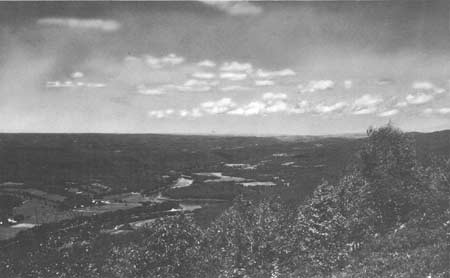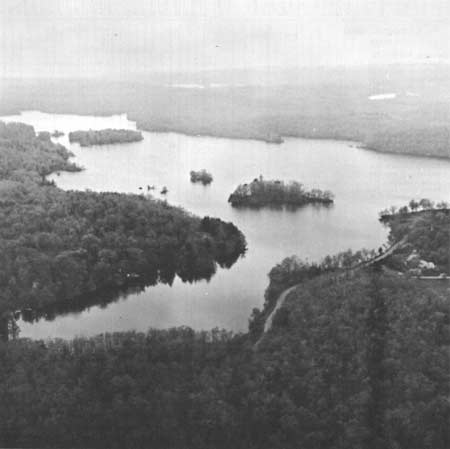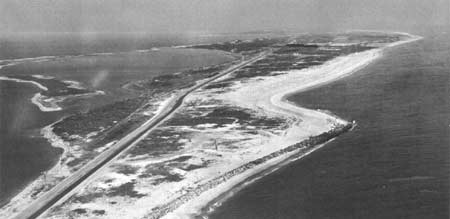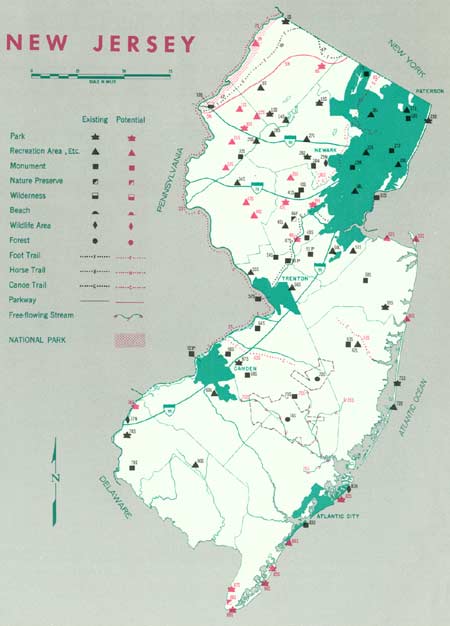.gif)
Parks for America
MENU
|
Parks for America
|

|

|
| A 33-mile-long reservoir is authorized for the Delaware River Valley in New Jersey and Pennsylvania, above the Delaware Water Gap. Tocks Island National Recreation Area, proposed for the site, would be readily accessible to 15 percent of the U.S. population. |
NEW JERSEY
NEW JERSEY offers rugged hills and a long stretch of ocean shoreline that attracts millions of visitors each year. A representative number of the diversified recreation resources are in public and quasi-public ownership, but additional areas are needed to meet growing demands.
New Jersey has the second highest population density of the United States—an average of 806 per square mile in 1960. An exploding population in the last decade brought the 1960 census to 6,066,782. Eighty-eight percent live in urban areas. By 1976 an estimated 8,013,000 persons will reside in this State.
The tourist industry had an estimated value in excess of $600 million in 1960, ranking it third in the State's economy. Two counties on the coast regard the travel and vacation industry as their principal economic base. The Jersey shore ocean beaches are national targets, serving visitors from all States.
The ocean beaches, inlets, and rivers constitute the major recreation resources. Outdoor enjoyment is enhanced by a mild summer climate that draws a vast number of visitors to seashore and mountain areas. Winter sports are important in the Northern Appalachian Highlands. Lakes, swift-flowing streams, and scenic trails are noteworthy in this region. Fresh- and salt-water fishing is a favorite outdoor activity, as is upland game and deer hunting. The historical heritage is significant, with sites associated with the revolutionary and colonial themes. Four sites not in the National Park System are eligible for Registered National Historic Landmark status.
EXISTING PUBLIC AREAS
NATIONAL: Two monuments totaling 973 acres are administered by the National Park Service. The 1960 attendance was 528,300. The Bureau of Sport Fisheries and Wildlife manages three national wildlife refuges with 14,851 acres.
STATE: The Department of Conservation and Economic Development, Forests and Parks Section, administers 20 park areas, totaling 20,987 acres; 18 historic sites with 661 acres; and 12 forest areas with 162,516 acres. The 1960 attendance was 4,800,374. The Division of Fish and Game has public shooting and hunting areas totaling 88,000 acres. The Highway Department has 25 waysides.
LOCAL: There are approximately 112 local areas totaling 23,704 acres.
QUASI-PUBLIC AND PRIVATE: There are approximately 48 miles of the Appalachian Trail, a 135-acre nature preserve, and three historic monuments.
PRIVATE ENTERPRISE: The greater share of the day, weekend, and vacation recreation facilities are provided by private enterprise. The tourist industry is widespread and well developed.

|
| Lake Waywayanda, a potential State park area in northern New Jersey. |
PARK AND RELATED NEEDS
Of paramount importance is the need to reserve seashore areas. The high-density, fast-growing population points up the urgency of expanding the metropolitan and county park systems. Most State park areas are relatively undeveloped, and additional parks are needed. Plans should be devised by State and local governments to control land use.
In addition to parks and related areas as such, zoning is needed to preserve horse, foot, and canoe trails. Further study is needed on preserving free flowing streams. Historic sites need further development.
The "New Jersey Green Acres Bond Act of 1961," authorizing a $60 million bonding program for acquisition of recreation and conservation lands, will do much to advance State and local park and recreation programs.
For the present population of over 6 million, there are only 30,232 acres in State areas and 19,902 acres in local nonurban areas. Potential areas identified in this plan total 48,988 acres judged of State significance and 6,800 of local. Even if these areas are acquired and developed, they will not meet the anticipated needs by 1976.

|
| Sandy Hook, now an Army site, represents an important portential recreation area for New Jersey. The State now leases 460 acres there for public recreation use. |
RECOMMENDATIONS
Existing recreation resources and many potential areas are shown on the accompanying tabulation and map. If the following recommendations are implemented by vigorous action on the part of the agencies concerned, they may help to provide the additional outdoor recreation opportunities needed for public health and enjoyment.
NATIONAL: Establishment of the proposed Tocks Island Reservoir as a national recreation area, and cooperative study of an Appalachian Parkway, a portion of which would pass through New Jersey.
STATE: Expansion of the State park system to preserve valuable resources found in 8 potential park areas and 11 recreation areas. Designation and protection of certain free-flowing streams in their natural condition, such as the Mullica, Wading, and Batsto Rivers. Expansion and provision of easements for the existing systems of foot, horse, and canoe trails. Expansion of nature preserves within the State.
LOCAL: Acquire and develop additional county and metropolitan parks to help meet recreation needs. Establish parks in counties where such facilities are lacking.
Supporting recommendations include:
1. Inclusion of new wayside areas and protection of existing areas from excessive commercial development in highway program planning.
2. Development of a State land-use plan, aimed at coordinating State and local agencies in their planning endeavors for future park lands.
3. Continuation and early completion of the historic site and archeological survey.
(Table omitted from online edition)

|
| (click on image for an enlargement in a new window) |
NEXT >>>
|
|
Last Modified: Mon, Sep 6 2004 10:00:00 pm PDT
parks_america/new_jersey.htm
 Top
Top